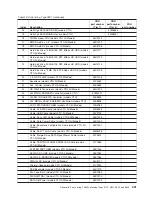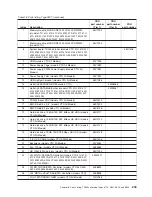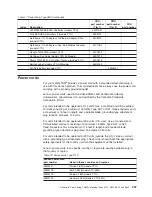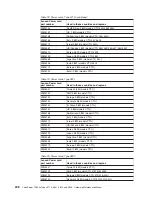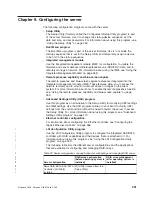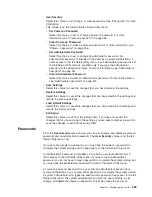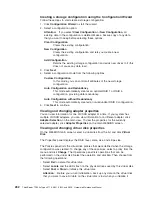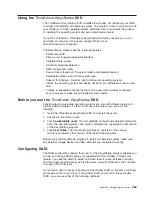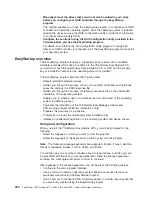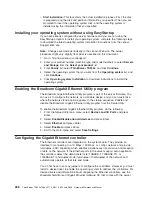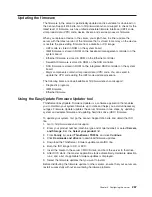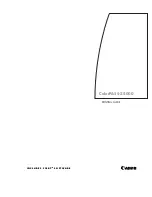
-
Network Configuration
Select this choice to view the system management network interface port,
the IMM MAC address, the current IMM IP address, and host name; define
the static IMM IP address, subnet mask, and gateway address; specify
whether to use the static IP address or have DHCP assign the IMM IP
address; save the network changes.
-
Reset IMM to Defaults
Select this choice to view or reset IMM to the default settings.
–
Adapters and UEFI Drivers
Select this choice to view information about the adapters and drivers in the
server that are compliant with UEFI 1.10 and UEFI 2.0.
v
Network
Select this choice to view or configure the network options, such as the iSCSI,
PXE, and network devices. There might be additional configuration choices for
optional network devices that are compliant with UEFI 2.1 and later.
v
Date and Time
Select this choice to set the date and time in the server, in 24-hour format
(
hour
:
minute
:
second
).
This choice is on the full Setup Utility menu only.
v
Start Options
Select this choice to view or boot to devices, including the startup sequence.
This choice is on the full Setup Utility menu only.
v
Boot Manager
Select this choice to view, add, delete, or change the device boot priority, boot
from a file, select a one-time boot, or reset the boot order to the default setting. If
the server has Wake on LAN hardware and software and the operating system
supports Wake on LAN functions, you can specify a startup sequence for the
WAKE on LAN functions. For example, you can define a startup sequence that
checks for media in a CD-RW/DVD drive, then checks the hard disk drive, and
then the network adapter.
v
System Event Logs
Select this choice to enter the System Event Manager, where you can view the
error messages in the system-event logs. You can use the arrow keys to move
between pages in the error log.
The system-event logs contain all event and error messages that have been
generated during POST, by the systems-management interface handler, and by
the system service processor. Run the diagnostic programs to get more
information about error codes that occur. See“Running the diagnostic programs”
on page 90 for instructions for running the diagnostic programs.
Important:
If the system-error LED on the front of the server is lit but there are
no other error indications, clear the system-event log. Also, after you complete a
repair or correct an error, clear the system-event log to turn off the system-error
LED on the front of the server.
–
POST Event Viewer
Select this choice to enter the POST event viewer to view the error messages
in the POST event log.
–
System Event Log
Select this choice to view the error messages in the system-event log.
–
Clear System Event Log
Select this choice to clear the system-event log.
254
ThinkServer TD200x Types 3719, 3821, 3822, and 3823: Hardware Maintenance Manual
Summary of Contents for THINKSERVER 3719
Page 1: ...ThinkServer TD200x Machine Types 3719 3821 3822 and 3823 Hardware Maintenance Manual ...
Page 2: ......
Page 3: ...ThinkServer TD200x Types 3719 3821 3822 and 3823 Hardware Maintenance Manual ...
Page 12: ...4 ThinkServer TD200x Types 3719 3821 3822 and 3823 Hardware Maintenance Manual ...
Page 22: ...14 ThinkServer TD200x Types 3719 3821 3822 and 3823 Hardware Maintenance Manual ...
Page 28: ...20 ThinkServer TD200x Types 3719 3821 3822 and 3823 Hardware Maintenance Manual ...
Page 34: ...26 ThinkServer TD200x Types 3719 3821 3822 and 3823 Hardware Maintenance Manual ...
Page 244: ...236 ThinkServer TD200x Types 3719 3821 3822 and 3823 Hardware Maintenance Manual ...
Page 258: ...250 ThinkServer TD200x Types 3719 3821 3822 and 3823 Hardware Maintenance Manual ...
Page 282: ...274 ThinkServer TD200x Types 3719 3821 3822 and 3823 Hardware Maintenance Manual ...
Page 286: ...278 ThinkServer TD200x Types 3719 3821 3822 and 3823 Hardware Maintenance Manual ...
Page 296: ...288 ThinkServer TD200x Types 3719 3821 3822 and 3823 Hardware Maintenance Manual ...
Page 303: ......
Page 304: ...Part Number XXXXXX Printed in USA 1P P N XXXXXX ...


